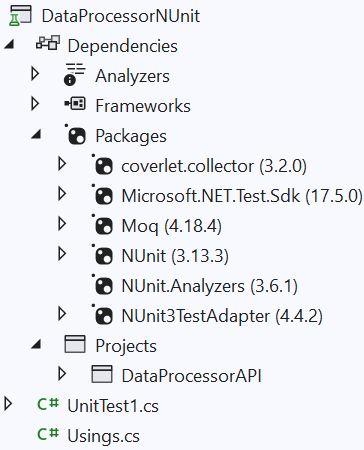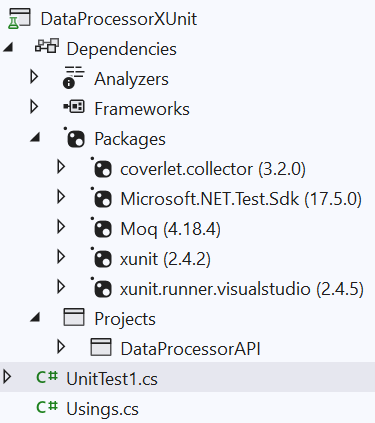We will create API Project
Then will create Class Library Project
Then will create NUnit & XUnit Project
Now we will see step by step with code snippet
I. In API Project>>DataProcessorController.cs file and below are code snippets
using DataProcessorLibrary.Models;
using DataProcessorLibrary.Repository;
using Microsoft.AspNetCore.Cors.Infrastructure;
using Microsoft.AspNetCore.Http;
using Microsoft.AspNetCore.Mvc;
using Newtonsoft.Json;
using Newtonsoft.Json.Linq;
namespace DataProcessorAPI.Controllers
{
[Route("api/[controller]")]
[ApiController]
public class DataProcessorController : ControllerBase
{
IRepository _repoService;
public DataProcessorController(IRepository repoService)
{
_repoService = repoService;
}
[HttpPost]
[Route("DataProcessor")]
public string DataProcessor(JObject data)
{
var clgInfo = data["college"].ToObject<College>();
var deptInfo = clgInfo.Departments[0];
var clsInfo = deptInfo.Classes[0];
var stdInfo = clsInfo.Students[0];
//var deptInfo = data["college"]["departments"].ToObject<Department>();
//var clsInfo = data["college"]["departments"][0]["classes"].Children().ToList();
//var stdInfo = data["college"]["departments"][0]["classes"][0]["students"].Children().ToList();
var clgresult = _repoService.AddCollege(clgInfo);
var deptresult = _repoService.AddDepartment(deptInfo);
var clsresult = _repoService.AddClass(clsInfo);
var stdresult = _repoService.AddStudent(stdInfo);
if (stdresult > 0)
{
return "saved";
}
else
{
return "not saved";
}
}
[HttpGet]
[Route("/GetStudentById")]
public async Task<IActionResult> GetStudentById(int id)
{
var result = _repoService.GetStudentById(id);
return result == null ? NotFound() : Ok(result);
}
[HttpGet]
[Route("/GetAllStudents")]
public async Task<IActionResult> GetStudents()
{
var result = _repoService.Students();
return result.Count() == 0 ? NotFound() : Ok(result);
}
[HttpGet]
[Route("/GetClassById")]
public async Task<IActionResult> GetClassById(int id)
{
var result = _repoService.GetClassById(id);
return result == null ? NotFound() : Ok(result);
}
[HttpGet]
[Route("/GetAllClasses")]
public async Task<IActionResult> GetClasses()
{
var result = _repoService.Classes();
return result.Count() == 0 ? NotFound() : Ok(result);
}
[HttpGet]
[Route("/GetDepartmentById")]
public async Task<IActionResult> GetDepartmentById(int id)
{
var result = _repoService.GetDepartmentById(id);
return result == null ? NotFound() : Ok(result);
}
[HttpGet]
[Route("/GetAllDepartments")]
public async Task<IActionResult> GetDepartments()
{
var result = _repoService.Departments();
return result.Count() == 0 ? NotFound() : Ok(result);
}
[HttpGet]
[Route("/GetCollegeById")]
public async Task<IActionResult> GetCollegeById(int id)
{
var result = _repoService.GetCollegeById(id);
return result == null ? NotFound() : Ok(result);
}
[HttpGet]
[Route("/GetAllColleges")]
public IActionResult GetColleges()
{
var result = _repoService.Colleges();
return result.Count() == 0 ? NotFound() : Ok(result);
}
}
}
II. In API Project>>appsettings.json file and below are code snippets
{
"Logging": {
"LogLevel": {
"Default": "Information",
"Microsoft.AspNetCore": "Warning"
}
},
"ConnectionStrings": {
"MyConn": "Data Source=(localdb)\\MSSQLLocalDB;Initial Catalog=CollegeDB; Integrated Security=True;Encrypt=Yes;TrustServerCertificate=True;"
},
"AllowedHosts": "*"
}
III. In API Project>>Program.cs file and below are code snippets
using DataProcessorLibrary.Models;
using DataProcessorLibrary.Repository;
using Microsoft.AspNetCore.Cors.Infrastructure;
using Microsoft.EntityFrameworkCore;
var builder = WebApplication.CreateBuilder(args);
// Add services to the container.
builder.Services.AddDbContext<DataProcessorDBContext>(x => x.UseSqlServer(builder.Configuration.GetConnectionString("MyConn")));
builder.Services.AddScoped<IRepository, RepositoryImpl>();
builder.Services.AddMvc().AddNewtonsoftJson();
builder.Services.AddControllers();
// Learn more about configuring Swagger/OpenAPI at https://aka.ms/aspnetcore/swashbuckle
builder.Services.AddEndpointsApiExplorer();
builder.Services.AddSwaggerGen();
var app = builder.Build();
// Configure the HTTP request pipeline.
if (app.Environment.IsDevelopment())
{
app.UseSwagger();
app.UseSwaggerUI();
}
app.UseAuthorization();
app.MapControllers();
app.Run();
IV. In Class Library Project>>Models>>Class1.cs file and below are code snippets
using System;
using System.Collections.Generic;
using System.ComponentModel.DataAnnotations;
using System.ComponentModel.DataAnnotations.Schema;
using System.Linq;
using System.Text;
using System.Threading.Tasks;
namespace DataProcessorLibrary.Models
{
public class College
{
[Key]
public int CollegeId { get; set; }
[Required]
public string Name { get; set; }
public string Address { get; set; }
public List<Department> Departments { get; set; }
}
public class Department
{
[Key]
public int DepartmentId { get; set; }
public string Name { get; set; }
public string HOD { get; set; }
// Foreign key
[ForeignKey("College")]
public int CollegeRefId { get; set; }
public College College { get; set; }
public List<Class> Classes { get; set; }
}
public class Class
{
[Key]
public int ClassId { get; set; }
public string Name { get; set; }
public string StaffName { get; set; }
public string Capacity { get; set; }
// Foreign key
[ForeignKey("Department")]
public int DepartmentRefId { get; set; }
public Department Department { get; set; }
public List<Student> Students { get; set; }
}
public class Student
{
[Key]
public int StudentId { get; set; }
public string Name { get; set; }
public string DateOfBirth { get; set; }
// Foreign key
[ForeignKey("Class")]
public int ClassRefId { get; set; }
public Class Class { get; set; }
}
}
V. In Class Library Project>>Models>>DataProcessorDBContext.cs file and below are code snippets
using Microsoft.EntityFrameworkCore;
using System;
using System.Collections.Generic;
using System.Linq;
using System.Text;
using System.Threading.Tasks;
namespace DataProcessorLibrary.Models
{
public class DataProcessorDBContext:DbContext
{
public DbSet<College> Colleges { get; set; }
public DbSet<Department> Departments { get; set; }
public DbSet<Class> Classes { get; set; }
public DbSet<Student> Students { get; set; }
public DataProcessorDBContext(DbContextOptions<DataProcessorDBContext> options) : base(options)
{ }
/*protected override void OnConfiguring(DbContextOptionsBuilder optionsBuilder)
{
base.OnConfiguring(optionsBuilder);
optionsBuilder.UseSqlServer("Data Source=(localdb)\\MSSQLLocalDB;Initial Catalog=CollegeDB; Integrated Security=True;Encrypt=Yes;TrustServerCertificate=True;");
}*/
}
}
VI. In Class Library Project>>Repository>>IRepository.cs file and below are code snippets
using DataProcessorLibrary.Models;
using System;
using System.Collections.Generic;
using System.Linq;
using System.Text;
using System.Threading.Tasks;
namespace DataProcessorLibrary.Repository
{
public interface IRepository
{
int AddStudent(Student std);
int AddClass(Class cls);
int AddDepartment(Department dept);
int AddCollege(College clg);
IEnumerable<Student> Students();
IEnumerable<Class> Classes();
IEnumerable<Department> Departments();
IEnumerable<College> Colleges();
Student GetStudentById(int id);
Class GetClassById(int id);
Department GetDepartmentById(int id);
College GetCollegeById(int id);
}
}
VII. In Class Library Project>>Repository>>RepositoryImpl.cs file and below are code snippets
using DataProcessorLibrary.Models;
using System;
using System.Collections.Generic;
using System.Linq;
using System.Text;
using System.Threading.Tasks;
namespace DataProcessorLibrary.Repository
{
public class RepositoryImpl:IRepository
{
private readonly DataProcessorDBContext context;
public RepositoryImpl(DataProcessorDBContext context)
{
this.context = context;
}
public int AddStudent(Student item)
{
try
{
context.Students.Add(item);
var res = context.SaveChanges();
if (res > 0)
{
return context.Students.Max(x => x.StudentId);
}
else
return 0;
}
catch
{
throw;
}
}
public int AddClass(Class item)
{
try
{
context.Classes.Add(item);
var res = context.SaveChanges();
if (res > 0)
{
return context.Classes.Max(x => x.ClassId);
}
else
return 0;
}
catch
{
throw;
}
}
public int AddDepartment(Department item)
{
try
{
context.Departments.Add(item);
var res = context.SaveChanges();
if (res > 0)
{
return context.Departments.Max(x => x.DepartmentId);
}
else
return 0;
}
catch
{
throw;
}
}
public int AddCollege(College item)
{
try
{
context.Colleges.Add(item);
var res = context.SaveChanges();
if (res > 0)
{
return context.Colleges.Max(x => x.CollegeId);
}
else
return 0;
}
catch
{
throw;
}
}
public IEnumerable<Student> Students()
{
try {
return context.Students.ToList();
}
catch {
throw;
}
}
public IEnumerable<Class> Classes()
{
try
{
return context.Classes.ToList();
}
catch
{
throw;
}
}
public IEnumerable<Department> Departments()
{
try
{
return context.Departments.ToList();
}
catch
{
throw;
}
}
public IEnumerable<College> Colleges()
{
try
{
return context.Colleges.ToList();
}
catch
{
throw;
}
}
public Student GetStudentById(int id)
{
try
{
var data = context.Students.Where(c => c.StudentId == id).FirstOrDefault();
if (data != null)
return data;
else
throw new Exception("Invalid StudentId ID");
}
catch
{ throw; }
}
public Class GetClassById(int id)
{
try
{
var data = context.Classes.Where(c => c.ClassId == id).FirstOrDefault();
if (data != null)
return data;
else
throw new Exception("Invalid ClassId ID");
}
catch
{ throw; }
}
public Department GetDepartmentById(int id)
{
try
{
var data = context.Departments.Where(c => c.DepartmentId == id).FirstOrDefault();
if (data != null)
return data;
else
throw new Exception("Invalid DepartmentId ID");
}
catch
{ throw; }
}
public College GetCollegeById(int id)
{
try
{
var data = context.Colleges.Where(c => c.CollegeId == id).FirstOrDefault();
if (data != null)
return data;
else
throw new Exception("Invalid CollegeId ID");
}
catch
{ throw; }
}
}
}
VIII. In NUnit Project>>UnitTest1.cs file and below are code snippets
using DataProcessorAPI.Controllers;
using DataProcessorLibrary.Models;
using DataProcessorLibrary.Repository;
using Microsoft.AspNetCore.Cors.Infrastructure;
using Moq;
namespace DataProcessorNUnit
{
public class Tests
{
private DataProcessorController controller;
private Mock<IRepository> repositoryMock;
private Mock<College> collegeMock;
private List<College> clgListMock;
[SetUp]
public void Setup()
{
repositoryMock = new Mock<IRepository>();
collegeMock = new Mock<College>();
clgListMock = new List<College>()
{
collegeMock.Object
};
repositoryMock.Setup(c => c.Colleges()).Returns(clgListMock.AsEnumerable());
controller = new DataProcessorController(repositoryMock.Object);
}
[Test]
public void Test1()
{
Assert.IsNull(clgListMock);
Assert.Pass();
}
}
}
IX. In XUnit Project>>UnitTest1.cs file and below are code snippets
using DataProcessorAPI.Controllers;
using DataProcessorLibrary.Repository;
using Microsoft.AspNetCore.Http;
using Microsoft.AspNetCore.Mvc;
using Moq;
namespace DataProcessorXUnit
{
public class UnitTest1
{
//private Mock<IRepository> serviceMock;
IRepository serviceMock;
public UnitTest1(IRepository repoService)
{
serviceMock = repoService;
}
[Fact]
public void GetAllCollegesSuccess()
{
//Setup of Pre-requisites
var controller = new DataProcessorController(serviceMock);
//Act
var response = controller.GetColleges();
var content = response as OkObjectResult;
Assert.Equal(StatusCodes.Status200OK, content.StatusCode);
//Assert.Equal(200, content.StatusCode);
}
}
}




No comments:
Post a Comment